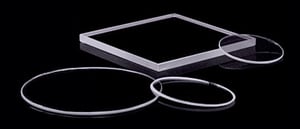What is super-polishing?
Super-polishing is a new classification for optical surface quality, sometimes referred to as "atomically smooth." By this we mean surface roughness features that can be measured in Angstroms, which are ten times smaller than nanometers. A single hydrogen atom is roughly 1 Å in diameter, so super-polishing really is “atomic.” By comparison, a λ/100 specification is 6 nm.
Why does super-polishing matter?
In many cases optical surface roughness and scratch-dig are only cosmetic. (Which is why you shouldn’t over-tolerance optical specifications!) Surface defects cause light to scatter but have little or no effect on wavefront or chromatic aberrations. That said, there are plenty of circumstances for which light scatter is a significant concern. For example, in high-energy laser systems, surface defects can absorb energy, leading to thermal damage that can be literally explosive. At the opposite end of the energy spectrum, in low-light instruments such as telescopes and medical imaging, every photon lost through scattering reduces image brightness and contrast.
How is super-polishing defined?
That’s the tricky part. At present, there is not an industrial definition of what "super-polished" means. This is not entirely surprising because defining and classifying surface defects still relies on visual inspection, and it is thus open to variable interpretation. At Ross, we can achieve a surface quality of 10-5.
3 Tips for Ordering Super-Polished Optics
There are three critical things to keep in mind when ordering super-polished optics…
- Communication: There is not an industry-wide definition of what super-polishing is, how it is measured, and how it is reported. It is very important that you and your vendor mutually understand and agree to the specifications and tolerances.
- Metrology: Super-polishing is at the frontier of current manufacturing technology. Without precise and consistent methods of measurement, it is impossible to know if the parts truly meet the specifications.
- Trust: It is critical to work with a vendor with high integrity. Customers who do not own sub-nanometer metrology equipment will have to rely on the vendor's quality-control measurements.
Ross is very excited to now offer super-polishing as a new option for customers. We presently offer parts with RMS roughness of 0.1 nm and scratch/dig tolerances of 10-5 for parts with diameter 5–300 mm and thickness 0.5–30 mm. Materials include silicon, Zerodur, fused silica and many other visible-light materials. We also have the facilities to perform cleanroom optical assembly and testing to eliminate the risk of contamination or damage during shipping and handling.
Give us a call to learn how Ross can meet your super-polishing needs, or visit us at Photonics West 2018, Booth #2541.
Learn more about avoiding over-specification in optical design by downloading our tolerancing guide.





